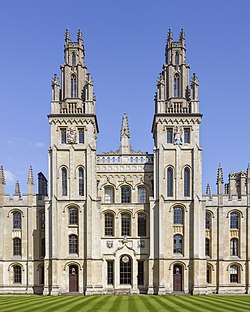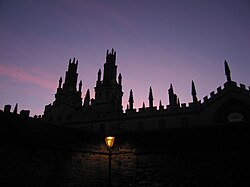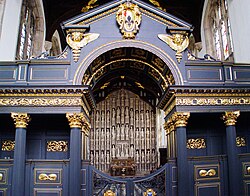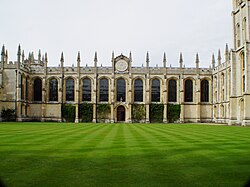All Souls College, Oxford: Difference between revisions
Created page with "{{Infobox college |name=All Souls College |full name=College of All Souls of the Faithful Departed |latin=Collegium Omnium Animarum Fidelium Defunctorum de Oxonia |county=Oxfo..." |
No edit summary |
||
| (One intermediate revision by the same user not shown) | |||
| Line 2: | Line 2: | ||
|name=All Souls College | |name=All Souls College | ||
|full name=College of All Souls of the Faithful Departed | |full name=College of All Souls of the Faithful Departed | ||
|latin=Collegium Omnium Animarum Fidelium Defunctorum de Oxonia | |latin=Collegium Omnium Animarum<br />Fidelium Defunctorum de Oxonia | ||
|county=Oxfordshire | |county=Oxfordshire | ||
|university=Oxford | |university=Oxford | ||
| Line 17: | Line 17: | ||
|scarf= | |scarf= | ||
|established=1438 | |established=1438 | ||
| | |principal title=Warden | ||
|principal=Sir John Vickers | |||
|endowment=£420.2 million (2018) | |endowment=£420.2 million (2018) | ||
|website=https://www.asc.ox.ac.uk/ | |website=https://www.asc.ox.ac.uk/ | ||
Latest revision as of 22:20, 8 March 2024
| All Souls College Latin: Collegium Omnium Animarum Fidelium Defunctorum de Oxonia
| |
 The twin towers of Hawksmoor's Quadrangle | |
|---|---|
 | |
| Warden: | Sir John Vickers |
| Website: | https://www.asc.ox.ac.uk/ |
| Location | |
| Grid reference: | SP516063 |
| Location: | 51°45’12"N, 1°15’11"W |
All Souls College, officially the College of the Souls of All the Faithful Departed, is a constituent college of the University of Oxford. Unique to All Souls, all of its members automatically become fellows, which is to say full members of the college's governing body. It has no undergraduate members, but each year, recent graduate and postgraduate students at Oxford are eligible to apply for a small number of examination fellowships through a competitive examination (once described as "the hardest exam in the world") and, for those shortlisted after the examinations, an interview.
The college entrance is on the north side of High Street, whilst it has a long frontage onto Radcliffe Square. To its east is The Queen's College, whilst Hertford College is to the north of All Souls.
History
The college was founded by King Henry VI and Henry Chichele (a fellow of New College and Archbishop of Canterbury), in 1438, to commemorate the victims of the Hundred Years' War.[1] The Statutes provided for a warden and forty fellows; all to take Holy Orders: 24 to study arts and theology; and 16 to study civil or canon law.[2]
Today the college is primarily a graduate research institution, with no undergraduate members. All Souls did formerly have undergraduates: Robert Hovenden (Warden of the college from 1571 to 1614) introduced undergraduates to provide the fellows with servientes (household servants), but this was abandoned by the end of the Commonwealth period. Four Bible Clerks remained on the foundation until 1924.
For over five hundred years All Souls College admitted only men; women were first allowed to join the college as fellows in 1979,[3] the same year as many other previously all-male colleges in the university.[4]
Buildings and architecture
All Souls College Library

The All Souls College Library (formerly known as the Codrington Library) was founded through a 1710 bequest from Christopher Codrington (1668–1710), a fellow of the college and a wealthy slave and sugar plantation owner. Codrington was an undergraduate at Oxford and later became colonial governor of the Leeward Islands. Christopher Codrington was born in Barbados, and amassed a fortune from his sugar plantation in the West Indies.[5]
Under the terms of his will Codrington bequeathed books worth £6,000 to the college in addition to £10,000 in currency for the library to be rebuilt and endowed. The new library was completed in 1751 to the designs of Nicholas Hawksmoor and has been in continuous use since then. Today the library comprises some 185,000 items, about a third of which were published before 1800. The collections are particularly strong in law and history (especially military history).[6]
Sir Christopher Wren was a fellow from 1653. The design of the sundial, produced in 1658 for the south wall of the Chapel, is attributed Wren. The sundial was moved to the quadrangle (above the central entrance to the Library) in 1877.[7]
In 2020, the College decided to cease referring to the Library as 'The Codrington Library' as part of a set of "steps to address the problematic nature of the Codrington legacy", which comes from wealth derived from slave plantations.[8]
Chapel
Built between 1438 and 1442, the college chapel remained largely unchanged until the Commonwealth period. Oxford, having been a largely Royalist stronghold, suffered under the Puritans' wrath. The 42 misericords date from the Chapel's building, and show a resemblance to the misericords at St Mary's Church, Higham Ferrers. Both may have been carved by Richard Tyllock. During the 1660s a screen was installed in the Chapel, which was based on a design by Wren. However, this screen needed to be rebuilt by 1713. By the mid-19th century the Chapel was in great need of renovation, and so the current structure is heavily influenced by Victorian design ideals. There have been a number of rearrangements and repairs of the stained glass windows, but much of the original mediæval glass survives.[9]
All services at the chapel are according to the Book of Common Prayer; the King James Bible is also used rather than more modern translations.
Wealth
All Souls is one of the wealthiest colleges in Oxford, with a financial endowment of £420.2 million (2018).[10] However, since the college's principal source of revenue is its endowment and it does not earn income from tuition fees, it only ranked 19th (in 2007) among Oxford colleges in total income. All Souls is a registered charity.[11]
Customs
Every hundred years, and generally on 14 January, there is a commemorative feast after which the fellows parade around the college with flaming torches, singing the Mallard Song and led by a "Lord Mallard" who is carried in a chair, in search of a legendary mallard that supposedly flew out of the foundations of the college when it was being built.[12] During the hunt the Lord Mallard is preceded by a man bearing a pole to which a mallard is tied – originally a live bird, latterly either dead (1901) or carved from wood (2001). The last mallard ceremony was in 2001[13] and the next is due in 2101.
The precise origin of the custom is not known, but it dates from at least 1632.[14] A benign parody of this custom has been portrayed as the Unseen University's "Megapode chase" in Sir Terry Pratchett's 2009 novel Unseen Academicals.
Pictures
| ("Wikimedia Commons" has material about All Souls College, Oxford) |
-
The gates on Radcliffe Square
-
A view of All Souls from the Radcliffe Square gate, showing Nicholas Hawksmoor's 'gothicised classical' elevation.
-
The south eastern corner of All Souls College, abutting Radcliffe Square
-
All Souls Quad abutting High Street
-
All Souls College as viewed from New College Lane
-
The spires of All Souls
-
All Souls College at twilight
-
View from St Mary the Virgin's tower
-
All Souls College Chapel - the stone altar reredos seen through the later classical screen
-
All Souls College
-
All Souls College
-
All Souls College
Outside links
| ("Wikimedia Commons" has material about All Souls College, Oxford) |
References
- ↑ Simmonds, Tricia (1989). In and Around Oxford. Bath: Unichrome. p. 24. ISBN 1-871004-02-0.
- ↑ A History of the County of Oxford - Volume 3 pp 173-193: All Souls College (Victoria County History)
- ↑ "All Souls College Oxford". University of Oxford. https://www.asc.ox.ac.uk/modern-college.
- ↑ "Women at Oxford | University of Oxford". University of Oxford. http://www.ox.ac.uk/about/oxford-people/women-at-oxford.
- ↑ James Walvin, Slavery and the Building of Britain, BBC.
- ↑ "Codrington Library". all-souls.ac.uk.
- ↑ "Architecture of the College | All Souls College". https://www.asc.ox.ac.uk/architecture-college.
- ↑ All Souls College Library, Library History[1]
- ↑ Hutchinson, F. E. (1949). Mediæval Glass at All Souls College. London, UK: Faber and Faber. OCLC 1269744.
- ↑ "All Souls College : Annual Report and Financial Statements for the year ended 31 July 2018". University of Oxford. p. 50. http://d307gmaoxpdmsg.cloudfront.net/collegeaccounts1718/allsouls.pdf.
- ↑ The College of All Souls of the Faithful Departed, of Oxford - Registered Charity no. 1138057 at the Charity Commission
- ↑ "Hunting the Mallard, Oxfordshire". http://www.information-britain.co.uk/customdetail.php?id=59.
- ↑ "Mallard leads Oxford fellows a merry dance". https://www.telegraph.co.uk/news/uknews/1314859/Mallard-leads-Oxford-fellows-a-merry-dance.html.
- ↑ HOLE, Christina, English Custom and Usage, London, Batsford, 1941, p.28: "...we know that the custom existed at least as early as 1632, for in that year Archbishop Abbot censured the college for a riot "in pretence of a foolish Mallard". "Mallard" has since become a colloquialism at the college, generally meaning "rubbish".
| Colleges of the University of Oxford | |
|---|---|
| Colleges:
All Souls • Balliol • Brasenose • Christ Church • Corpus Christi • Exeter • Green Templeton • Harris Manchester • Hertford • Jesus • Keble • Kellogg • Lady Margaret Hall • Linacre • Lincoln • Magdalen • Mansfield • Merton • New College • Nuffield • Oriel • Pembroke • The Queen's • Reuben • St Anne's • St Antony's • St Catherine's • St Cross • St Edmund Hall • St Hilda's • St Hugh's • St John's • St Peter's • Somerville • Trinity • University • Wadham • Wolfson • Worcester |
 |
| Permanent private halls:
Blackfriars • Campion Hall • Regent's Park College • St Benet's Hall • St Stephen's House • Wycliffe Hall | |












